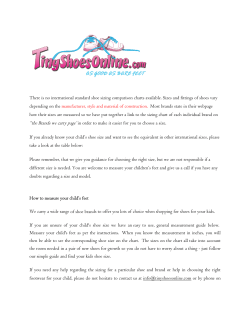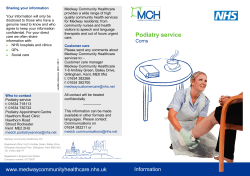
Getting to Know Your Feet Common Foot Ailments
HSW-PAR.821 Getting to Know Your Feet Common Foot Ailments This list includes some common foot ailments. Foot ailments that may affect people with certain disease such as diabetes, high blood pressure, circulatory problems, and runners will be discussed in detail later. Athlete’s Foot Athlete’s foot is a skin disease that generally starts between the toes and soles of the feet. It is caused by a fungus and is highly contagious. Athlete’s foot can be spread from person to person or by contact with objects such as public showers, spas, swimming pools or nail salons. Signs and symptoms include dry, scaly skin, itching, inflammation (redness and swelling), and blisters. It is important to change shoes, not wearing the same ones you have been wearing, to prevent the spread of athlete’s foot and promote healing of current infection. Any socks or hosiery you have worn must be washed and changed on a regular basis. Contact your health care provider if you suspect an infection. Blisters Blisters are caused by friction on the foot from poor fitting shoes or wearing shoes without socks. Always wear socks or hose with your shoes. Keep your feet dry and do not pop the blister. You can apply a bandage such as a moleskin bandage over the blister to promote healing and decrease the chance of opening the blister. If the blister pops on its own, carefully wash the blister, apply an antiseptic, and cover with a clean, sterile bandage. If you have diabetes and find a blister consult your health care provider for treatment. Do not treat the blister yourself. Bunions Bunions are misaligned big toes. The joint becomes swollen and painful. Signs of a bunion include the big toe joint slanting outward with the big toe turning toward the other toes. Bunions tend to be hereditary or run in families. Wearing shoes that do not fit properly, generally too narrow, tend to bring on bunions. If you suspect you have a bunion consult your health care provider for a treatment plan. Corns and Calluses Corns and calluses are layers of dead skin cells. These too are caused from poorly fitting shoes, which create a constant friction to areas of the toes and soles of the feet. Corns generally form on the toes and calluses on the soles of the feet. These may become painful. You can apply moleskin to ease the pain and decrease friction. Never cut off the corn or callus yourself. If you have diabetes consult your health care provider. Do not treat corns or calluses yourself. Foot Odor The foot contains 250,000 sweat glands. Sweating is inevitable. Without daily foot care, such as washing and changing socks, foot odor can occur. But, some people are more prone to excessive foot odor than others. There are numerous over-the-counter foot powders, sprays, and inserts that can help lessen foot odor. Ask your health care provider for recommendations on these treatments. Ingrown Toenails Ingrown toenails are nails in which the corner or side grows painfully into the skin. Ingrown toenails may cause extreme pain or discomfort or may not cause any pain at all. The cause of ingrown toenails is generally from improper nail trimming and shoes not fitting properly (too small or too tight), fungal infections, family history, and foot anatomy. If the ingrown toenail becomes infected or is causing extreme pain, seek medical treatment from your health care provider. Diabetics are more prone to infection. They should always seek medical assistance when trimming toenails to avoid ingrown toenails. Hammertoes Hammertoe is a condition in which the toes bend into a claw-like position. It is more common in the second toe although it can occur in any of the three smaller toes. Hammertoe is caused from poorly fitting shoes as well as muscle imbalance. Buying and wearing properly fitting shoes is very important to prevent this condition. If you suspect you may have hammertoe, consult your health care provider for treatment options. Heel Pain Heel pain is caused from too much stress being placed on the heel, ligaments, and nerves. It can stem from poorly fitting shoes or from standing or bouncing on hard surfaces for long periods of time. Being overweight or having gout, arthritis, and circulatory problems will also increase the chance of heel pain. Heel Spurs Heel spurs are an overgrowth of bone on the heel. They generally do not cause pain unless they become inflamed. They are often associated with plantar fascitis, an inflammation of connective tissue that connects the heel to the ball of the foot. If you suspect an inflamed heel spur contact your health care provider for treatment options. Warts Warts are caused by a virus and are contagious. The virus enters the body through tiny cuts or scrapes in the skin. Warts are more often seen in children but adults can be affected as well. Warts may also be caused from walking barefoot on dirty surfaces. Warts generally are not painful. Consult your health care provider for treatment options. There are numerous over-the-counter treatment options available and your health care provider is better able to recommend the best option. Plantar Fascitis The plantar fascia is the connective band of tissue that runs from the heel to the ball of the foot. Excessive pressure or excessive stretching of this band of tissue can cause 2 inflammation. Symptoms include heel pain. If you suspect you have plantar fascitis consult your health care provider to discuss treatment options. Neuroma A neuroma is a benign growth of a nerve. It occurs most commonly between the third and fourth toe. It is caused from bones rubbing together and causing nerve irritation or from poorly fitting shoes or an abnormal bone structure. Symptoms include pain, burning, or numbness between the toes into the ball of the foot. If you suspect you have a neuroma consult your health care provider for treatment options. Adapted for use in Kentucky from the American Podiatry Medical Association (2008). General Foot Health. Available online at http://www.apma.org/s_apma/doc.asp?CID=371&DID=9406. This is a publication in an eight-part series on Getting to Know Your Feet. Other publications in this series are: o Overview: HSW-PAR.820 o Aging Feet: HSW-PAR.822 o Arthritis: HSW-PAR.823 o Diabetes: HSW-PAR.824 o Injuries: HSW-PAR.825 o Information for Women: HSW-PAR.826 o Walking for Health: HSW-PAR.827 Peggy Riley, RN, MSN Extension Health Specialist June 2008 Copyright © 2008 for materials developed by University of Kentucky Cooperative Extension. This publication may be reproduced in portions or its entirety for educational or nonprofit purposes only. Permitted users shall give credit to the author(s) and include this copyright notice. Educational programs of Kentucky Cooperative Extension serve all people regardless of race, color, age, sex, religion, disability, or national origin. 3
© Copyright 2025





















